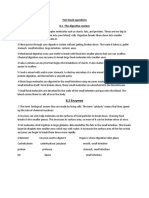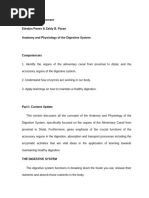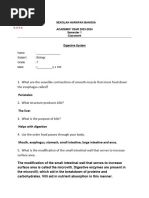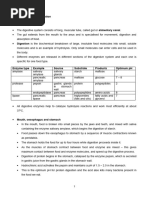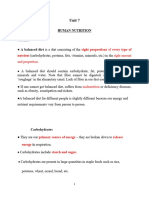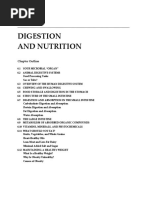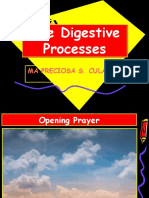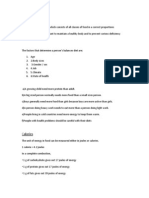Evaluation
Evaluation
Uploaded by
Muchammad NizarCopyright:
Available Formats
Evaluation
Evaluation
Uploaded by
Muchammad NizarCopyright
Available Formats
Share this document
Did you find this document useful?
Is this content inappropriate?
Copyright:
Available Formats
Evaluation
Evaluation
Uploaded by
Muchammad NizarCopyright:
Available Formats
Name :
Class :
EVALUATION
PART 1 Vocabulary
The following vocabulary words are from The Human Digestive System. Fill in the number of
each word next to its closest definition. VOCABULARY
1. _____ organ that stores bile
1. amino acids 7. lipids
2. _____ building blocks of protein
2. bile 8. liver
3. _____ first portion of the small intestine
3. carbohydrates 9. pancreas
4. _____ main building material of all cells
4. duodenum 10. proteins
5. _____ aids protein digestion in the stomach
5. gallbladder 11. starches
6. _____ largest gland in the body and producer of bile
6. hydrochloric acid 12. villi
7. _____ organic compounds such as fat and cholesterol
8. _____ gland which secretes enzymes for all types of digestion
9. _____ foods that include bread, pasta and potatoes
10. _____ group of compounds that includes starches and sugars
11. _____ fluid which breaks down fats in the small intestine
12. _____ fingerlike projections that increase surface area of the small intestine
PART 2 Checking Comprehension
Read the following sentences and circle the letters of the words that best fill each blank.
The human digestive system is a group of organs that break down food into
_____1_____ to be used as fuel by the body. Digestive juices, which are mostly _____2_____
, speed up this breakdown. Carbohydrates are changed into _____3_____ , fats are digested
into _____4_____ , and proteins are broken down into _____5_____ and amino acids.
Digestion begins in the mouth, where food is ground into smaller particles, and an enzyme
breaks down some of the _____6_____. In the stomach, _____7_____ such as hydrochloric
The Human Digestive System 1
acid begin the breakdown of protein. Fats and starches move on to the _____8_____, where
most of the digestive process takes place. Fluid secreted by the _____9_____ and
_____10____ , which is made in the liver, help digest fat. Enzymes secreted by glands in the
walls of the small intestine continue to break down _____11____. Capillaries and lymph
vessels in the _____12____ absorb the digested food and carry it to the body.
Vocabulary
Molecules enzymes simple sugars
Peptides starches fatty acid and glycerol
Small intestine villi starches and proteins
Bile pancreas gastric juices
PART 3 Multiple Choice
Check the correct answer to each question.
1. How does saliva digest food?
❑ by breaking down starches
❑ by using bile to break down sugars
❑ by breaking down proteins
❑ by using peptides to break down fat
2. The first segment of the small intestine is called the:
❑ villus ❑ colon
❑ duodenum ❑ illeum
3. The volume of the human stomach is approximately:
❑ one liter ❑ one-half of a liter
❑ two liters ❑ four liters
4. What are the walls of the stomach lined with?
❑ blood vessels and bile ducts
❑ villi and mucus membranes
❑ blood vessels and intestinal glands
❑ lymph vessels and villi
5. Enzymes in the gastric juices break proteins down into:
❑ lipids ❑ amylase
The Human Digestive System 2
❑ amino acids ❑ simple sugars
6. What type of food begins the digestion process in the small intestine?
❑ starches ❑ sugars
❑ proteins ❑ fats
7. What happens in the duodenum?
❑ food is mixed with pancreatic juice and bile
❑ vitamins and minerals are absorbed
❑ food is crushed by strong muscles and mixed with digestive juices
❑ a large amount of water is absorbed from the food
8. What are the functions of the intestinal juices?
❑ to continue breaking down starches and proteins
❑ to begin breaking down fats
❑ to begin breaking down starches and proteins
❑ to break down vitamins and minerals
9. Where do amino acids and glucose go after being absorbed by the villi?
❑ to the gallbladder
❑ to the large intestine
❑ to the liver
❑ to the lymph vessels
10. Blood vessels in the large intestine absorb:
❑ protein
❑ minerals and water
❑ bile
❑ starches
---- Good Luck ----
The Human Digestive System 3
You might also like
- PHC Exam Revision Questions Test A v2Document18 pagesPHC Exam Revision Questions Test A v2Anonymous TZQNraBL100% (15)
- Unlearn Your Pain Chapter 5 TMSDocument17 pagesUnlearn Your Pain Chapter 5 TMSSyedNo ratings yet
- Science 8 Q4 Revised Module 1 2Document24 pagesScience 8 Q4 Revised Module 1 2Rai0% (1)
- The Digestive System (G9)Document26 pagesThe Digestive System (G9)reem bitarNo ratings yet
- Circulatory+Digestive System 2Document20 pagesCirculatory+Digestive System 2madeleine.gaudissartNo ratings yet
- Science Grade 8: Quarter 4 - Module 1 The Digestive SystemDocument16 pagesScience Grade 8: Quarter 4 - Module 1 The Digestive Systemelize kay zapantaNo ratings yet
- C14 PPT Slides Small VerDocument61 pagesC14 PPT Slides Small VerryanthngkjNo ratings yet
- SCIENCE. 8 Q4 Week-1 7Document39 pagesSCIENCE. 8 Q4 Week-1 7Javier AugustNo ratings yet
- Grade 8 Q4 Module 1 The Digestive System 2nd EdDocument12 pagesGrade 8 Q4 Module 1 The Digestive System 2nd EdJay's JawlineNo ratings yet
- Chapter 8 Answer KeyDocument2 pagesChapter 8 Answer Keyzakiya100% (1)
- Unit 4 - Digestive SystemDocument31 pagesUnit 4 - Digestive SystemAbdullah MohammedNo ratings yet
- Module 1Document24 pagesModule 1nutssdeez944No ratings yet
- 9-BIO-8 MCQs (Web)Document3 pages9-BIO-8 MCQs (Web)Shahbaz AnwarNo ratings yet
- Unit 7 Study GuideDocument5 pagesUnit 7 Study GuideSierra MarieNo ratings yet
- IP Pre-Worksheet GIDocument6 pagesIP Pre-Worksheet GIstormigirl017No ratings yet
- The DIGESTIVE SYSTEMDocument22 pagesThe DIGESTIVE SYSTEMellaine.garciaNo ratings yet
- Learning Enhancement- Paired Activity(Panes&Paran)Document28 pagesLearning Enhancement- Paired Activity(Panes&Paran)edralyn panesNo ratings yet
- Topic B6.2 Alimentary Canal and 6.3 DigestionDocument33 pagesTopic B6.2 Alimentary Canal and 6.3 DigestionCrystalNo ratings yet
- Lesson: Digestive System: Activity 1Document5 pagesLesson: Digestive System: Activity 1Akane ForestNo ratings yet
- Science and Health: Digestive SystemDocument13 pagesScience and Health: Digestive SystemAnonymous yIlaBBQQ100% (1)
- Untitled DocumentDocument5 pagesUntitled Documentrichieco.saichi.studentNo ratings yet
- Science8 Q4 M1Document16 pagesScience8 Q4 M1Cristy VillamorNo ratings yet
- Science and Health: Digestive SystemDocument17 pagesScience and Health: Digestive SystemEDUARDO ACERONo ratings yet
- Student Exploration: Digestive System: V.M.Dhruv 13/8/21Document10 pagesStudent Exploration: Digestive System: V.M.Dhruv 13/8/21Dhruv VmNo ratings yet
- Name - Digestive System Worksheet: Salivary GlandsDocument5 pagesName - Digestive System Worksheet: Salivary GlandsRJ CamarilloNo ratings yet
- NUTRITION Notes 2020Document17 pagesNUTRITION Notes 2020hopemodise330No ratings yet
- Chapter 6 - Nutrition (Part 1)Document41 pagesChapter 6 - Nutrition (Part 1)Ema FatimahNo ratings yet
- Chapter 1Document16 pagesChapter 1Mursaleen KhanNo ratings yet
- Biology 13A Lab #13: Nutrition and Digestion: Expected Learning OutcomesDocument13 pagesBiology 13A Lab #13: Nutrition and Digestion: Expected Learning Outcomesdavin gunawanNo ratings yet
- 6.1 Digestion and Absorption: Digestion of Food MoleculesDocument24 pages6.1 Digestion and Absorption: Digestion of Food MoleculesWILSON KosheyNo ratings yet
- 8.4.4 Digestive SystemDocument22 pages8.4.4 Digestive SystemVaasviNo ratings yet
- Bio 203Document10 pagesBio 203madison dworskyNo ratings yet
- Human PhysiologyDocument43 pagesHuman PhysiologyBlowDatZaZaNo ratings yet
- IngestionDocument35 pagesIngestionMark FuntinillaNo ratings yet
- Science 8 q1Document4 pagesScience 8 q1juswa coralNo ratings yet
- 6 Human PhysiologyDocument29 pages6 Human PhysiologyRaynaahNo ratings yet
- Life Processes (Nutrition) - AnimalsDocument3 pagesLife Processes (Nutrition) - Animals08 - AVNEESH VERMANo ratings yet
- Nutrition in Animals 5Document16 pagesNutrition in Animals 5seema kadamNo ratings yet
- Unit 7 NotesDocument11 pagesUnit 7 Notesfathimath.saeedhaNo ratings yet
- MN The Human Digestive SystemDocument14 pagesMN The Human Digestive SystemelizabethNo ratings yet
- Science q4 ModuleDocument40 pagesScience q4 ModuleKesh Lisaba100% (1)
- Bacteria Enzymes in DigestionDocument16 pagesBacteria Enzymes in Digestionroselam226No ratings yet
- HandoutDocument6 pagesHandoutBehraz FareedNo ratings yet
- Accessory Organs of The Digestive SystemDocument19 pagesAccessory Organs of The Digestive SystemMais MarwanNo ratings yet
- Digestion Worksheet - Grade 10Document3 pagesDigestion Worksheet - Grade 10AVIVA CAMPBELLNo ratings yet
- Quarter 4 Module 1 DigestionDocument47 pagesQuarter 4 Module 1 Digestionfgabrielle1No ratings yet
- Digestive System Ingestion AbsorptionDocument44 pagesDigestive System Ingestion AbsorptionShang KirsteinNo ratings yet
- Human Digestive System-Note NewDocument7 pagesHuman Digestive System-Note Newtinsae tewodrosNo ratings yet
- Handouts On Digestion and NutritionDocument7 pagesHandouts On Digestion and NutritionKaye Selene Raphaelle Sy100% (1)
- Chapter 2 NutritionDocument20 pagesChapter 2 NutritionAzie Nurul AkhtarNo ratings yet
- Unit 2: Nutrients, Digestive System and Excretory SystemDocument27 pagesUnit 2: Nutrients, Digestive System and Excretory Systemapi-520057338No ratings yet
- Cot 2Document132 pagesCot 2Bing Sepe CulajaoNo ratings yet
- Organs of Alimentary Tract and Accessory Organs. Digestion Begins in The Mouth or Oral Cavity. It Contains 32 Teeth ThatDocument4 pagesOrgans of Alimentary Tract and Accessory Organs. Digestion Begins in The Mouth or Oral Cavity. It Contains 32 Teeth ThatRhea Mae PerezNo ratings yet
- I) FEEDING AND DIGESTIONDocument7 pagesI) FEEDING AND DIGESTIONamarashah182No ratings yet
- Animal Physiology^j Embryology Notes Paper IV Upto 3rd ModuleDocument25 pagesAnimal Physiology^j Embryology Notes Paper IV Upto 3rd ModulebollojubabaNo ratings yet
- Part I: Anatomy and Physiology of The Digestive SystemDocument6 pagesPart I: Anatomy and Physiology of The Digestive SystemLleana TanNo ratings yet
- Balance DietDocument6 pagesBalance DietYongAnn100% (1)
- Ruminants and Rodents: Biology Form 4:nutritionDocument30 pagesRuminants and Rodents: Biology Form 4:nutritionAzneezal Ar-RashidNo ratings yet
- Tarea de InglesDocument3 pagesTarea de InglesNatali de los santosNo ratings yet
- Digestive System NotesDocument6 pagesDigestive System NotesZah SchlafmützeNo ratings yet
- Parts of The Digestive System Matching Worksheet PDFDocument2 pagesParts of The Digestive System Matching Worksheet PDFMon Duray BalaniNo ratings yet
- Anatomy and Physiology: The Digestive System and Nutrition: Things You Should Know (Questions and Answers)From EverandAnatomy and Physiology: The Digestive System and Nutrition: Things You Should Know (Questions and Answers)No ratings yet
- LLB 2023-24Document6 pagesLLB 2023-24karamhussain4434No ratings yet
- New Application Form-1Document6 pagesNew Application Form-1BROTHERS CYBER100% (1)
- Certificate For Transfer: Milagrosa National High SchoolDocument22 pagesCertificate For Transfer: Milagrosa National High SchoolJenelyn DayaoNo ratings yet
- University of Delhi: Semester Examination May-June 2020 Statement of Marks/GradesDocument2 pagesUniversity of Delhi: Semester Examination May-June 2020 Statement of Marks/GradesM SRINIVAS RAONo ratings yet
- ADSA Lab ManualDocument73 pagesADSA Lab Manualpriyadharshinimr50No ratings yet
- Agniveer - Join Indian NavyDocument2 pagesAgniveer - Join Indian Navyramesh chaohanNo ratings yet
- Marcello Felisberto Morais de Assunção: Resumo Informado Pelo AutorDocument4 pagesMarcello Felisberto Morais de Assunção: Resumo Informado Pelo AutorMarcello AssunçãoNo ratings yet
- Teaching Philosophy: Progressivism "An Ounce of Experience Is Better Than A Ton of Theories"Document9 pagesTeaching Philosophy: Progressivism "An Ounce of Experience Is Better Than A Ton of Theories"Russel AporboNo ratings yet
- Article 1 Summary SheetDocument2 pagesArticle 1 Summary Sheetlatev123No ratings yet
- Contemporary IndiaDocument7 pagesContemporary IndiaAnonymous 3rEvauJiNo ratings yet
- DealingwithpeerpressureDocument9 pagesDealingwithpeerpressureShania Jane MarsabaNo ratings yet
- Sel Final PortfolioDocument52 pagesSel Final Portfolioapi-577375023No ratings yet
- Multiple Choice Test ConstructionDocument16 pagesMultiple Choice Test ConstructionJoanne Ico MagnayeNo ratings yet
- 3529202Document4 pages3529202HarishNo ratings yet
- Graduation Paper - Methodology-K08Document9 pagesGraduation Paper - Methodology-K08tiendanghia18101992No ratings yet
- 2024 Product Management TrendsDocument2 pages2024 Product Management TrendsGopinathNo ratings yet
- Historical RRLDocument2 pagesHistorical RRLMisandria AngelaNo ratings yet
- GRADE-11-Q1-Module-2-Life-in-Harmony-with-Others-1Document15 pagesGRADE-11-Q1-Module-2-Life-in-Harmony-with-Others-1GggggNo ratings yet
- EGRA English ProtocolDocument13 pagesEGRA English ProtocolRachelle Ramon GundayaoNo ratings yet
- I. Objectives: Teaching WeekDocument8 pagesI. Objectives: Teaching WeekBarbara PosoNo ratings yet
- Class 12th - Mechanism of Organic ReactionDocument13 pagesClass 12th - Mechanism of Organic Reactionmpgj75xxjmNo ratings yet
- Herbert Simon ContributionDocument10 pagesHerbert Simon Contributionarhamenterprises5401No ratings yet
- IPP Guide For IB HL TheatreDocument3 pagesIPP Guide For IB HL TheatreSofia KouznetsovaNo ratings yet
- IntroDocument28 pagesIntroHamid MojiryNo ratings yet
- Power and Politics PPT Final-1Document28 pagesPower and Politics PPT Final-1manglam singh100% (1)
- GR 11-IG Maths Syllabus Overview 2020-21Document5 pagesGR 11-IG Maths Syllabus Overview 2020-21AnikaNo ratings yet
- Jordan Clarke: Graphic DesignerDocument1 pageJordan Clarke: Graphic DesignerImmranNo ratings yet
- Entry Level Project Manager Resume ExampleDocument1 pageEntry Level Project Manager Resume ExampleazizkhouribgaNo ratings yet









